A Review on Shape Memory Alloys with Martensitic Transition at Cryogenic Temperatures
Abstract
1. Introduction
2. Cu-Based Systems
2.1. CuAlMn and CuAlMn-Based Systems
2.2. CuZn-Based and CuAl-Based Alloys
3. NiTi-Based Alloys
3.1. NiTiFe Alloys
3.2. Effect of Nb and Co on NiTi System
3.3. NiTiHf Alloys
3.4. NiTiSn Alloys
4. Ag-Based and FePt Alloys
5. CaFe2As2 Alloy
6. Cryogenic Magnetic SMA
7. Discussion
8. Conclusions
Author Contributions
Funding
Data Availability Statement
Conflicts of Interest
References
- Otsuka, K.; Ren, X. Physical metallurgy of Ti–Ni-based shape memory alloys. Prog. Mater. Sci. 2005, 50, 511–678. [Google Scholar] [CrossRef]
- Nespoli, A.; Besseghini, S.; Pittaccio, S.; Villa, E.; Viscuso, S. The high potential of shape memory alloys in developing miniature mechanical devices: A review on shape memory alloy mini-actuators. Sens. Actuators A Phys. 2010, 158, 149–160. [Google Scholar] [CrossRef]
- Shreekrishna, S.; Nachimuthu, R.; Nair, V.S. A review on shape memory alloys and their prominence in automotive technology. J. Intell. Mater. Syst. Struct. 2023, 34, 499–524. [Google Scholar] [CrossRef]
- Dana, A.; Vollach, S.; Shilo, D. Use the Force: Review of High-Rate Actuation of Shape Memory Alloys. Actuators 2021, 10, 140. [Google Scholar] [CrossRef]
- Nespoli, A.; Biffi, C.A.; Casati, R.; Passaretti, F.; Tuissi, A.; Villa, E. New developments on mini/micro shape memory actuators. In Smart Actuation and Sensing Systems—Recent Advances and Future Challenges; Berselli, G., Vertechy, R., Vassura, G., Eds.; IntechOpen Limited: London, UK, 2012; pp. 35–52. [Google Scholar] [CrossRef]
- Casagrande, L.; Villa, E.; Nespoli, A.; Occhiuzzi, A.; Bonati, A.; Auricchio, F. Innovative dampers as floor isolation systems for seismically-retrofit multi-storey critical facilities. Eng. Struct. 2019, 201, 109772. [Google Scholar] [CrossRef]
- Saedi, S.; Acar, E.; Raji, H.; Saghaian, S.E.; Mirsayar, M. Energy damping in shape memory alloys: A review. J. Alloys Compd. 2023, 956, 170286. [Google Scholar] [CrossRef]
- Patil, R.A.; Rane, S.B.; Kumbhar, S.B. Investigation of the damping behavior of shape memory alloy-nitinol reinforced composite. Eng. Res. Express 2022, 4, 045018. [Google Scholar] [CrossRef]
- Concilio, A.; Antonucci, V.; Auricchio, F.; Lecce, L.; Sacco, E. Shape Memory Alloy Engineering for Aerospace, Structural and Biomedical Applications; Butterworth—Heinemann: Oxford, UK; Elsevier Ltd.: Amsterdam, The Netherlands, 2021. [Google Scholar] [CrossRef]
- Wen, C.; Yu, X.; Zeng, W.; Zhao, S.; Wang, L.; Wan, G.; Huang, S.; Grover, H.; Chen, Z. Mechanical behaviors and biomedical applications of shape memory materials: A review. AIMS Mater. Sci. 2018, 5, 559–560. [Google Scholar] [CrossRef]
- Nespoli, A.; Dallolio, V.; Villa, E.; Passaretti, F. A new design of a Nitinol ring-like wire for suturing in deep surgical field. Mater. Sci. Eng. C 2015, 56, 30–36. [Google Scholar] [CrossRef]
- Barbarino, S.; Saavedra Flores, E.I.; Ajaj, R.M.; Dayyani, I.; Friswell, M.I. A review on shape memory alloys with applications to morphing aircraft. Smart Mater. Struct. 2014, 23, 55175494. [Google Scholar] [CrossRef]
- Borlandelli, E.; Scarselli, D.; Nespoli, A.; Rigamonti, D.; Bettini, P.; Morandini, M.; Villa, E.; Sala, G.; Quadrio, M. Design and experimental characterization of a NiTi-based, high-frequency, centripetal peristaltic actuator. Smart Mater. Struct. 2015, 24, 035008. [Google Scholar] [CrossRef]
- Chen, Q.F.; Zuo, X.B.; Wang, L.M.; Chang, W.; Tian, W.Y.; Li, A.Q.; Yang, H.; Liu, L.H. NiTi wire as a superelastic damping material in structural engineering. Mater. Sci. Eng. A 2006, 438–440, 1089–1092. [Google Scholar] [CrossRef]
- Tong, H.C.; Wayman, C.M. Characteristic temperatures and other properties of thermoelastic martensites. Acta Metall. 1974, 22, 887–896. [Google Scholar] [CrossRef]
- Trehern, W.; Ozcan, H.; Franco, B.; Hite, N.; Malone, N.; Loveall, B.; Morrison, T.D.; Benafan, O.; Karaman, I. Exploring thermomechanical functionality of CuAlMn as an extreme low temperature shape memory alloys. Mater. Lett. 2022, 308, 131246. [Google Scholar] [CrossRef]
- Bian, Z.; Song, J.; Liu, P.; Wan, F.; Lei, Y.; Wang, Q.; Yang, S.; Zhan, Q.; Chen, L.; Wang, J. In Situ Observation of Thermoelastic Martensitic Transformation of Cu-Al-Mn Cryogenic Shape Memory Alloy with Compressive Stress. Materials 2022, 15, 3794. [Google Scholar] [CrossRef] [PubMed]
- Zak, G.; Kneissl, A.C.; Zatulskij, G. Shape memory effect in cryogenic Cu–Al–Mn alloys. Scr. Mater. 1996, 34, 363–367. [Google Scholar] [CrossRef]
- Prado, M.O.; Lovey, F.C.; Civale, L. Magnetic properties of Cu–Mn–Al alloys with shape memory effect. Acta Mater. 1998, 46, 137–147. [Google Scholar] [CrossRef]
- Bubley, I.R.; Koval, Y.N.; Titov, P.V. β1→γ’ transformation in Cu–Mn–Al alloys after low temperature aging. Scr. Mater. 1999, 41, 637–641. [Google Scholar] [CrossRef]
- Omori, T.; Wang, J.; Sutou, Y.; Kainuma, R.; Ishida, K. Two-way shape memory effect induced by bending deformation in ductile Cu-Al-Mn alloys. Mater. Trans. 2002, 43, 1676–1683. [Google Scholar] [CrossRef]
- Shajil, N.; Das, D.; Chandrasekaran, L. Effects of cycling on the pseudoelastic properties of CuAlMnNi & TiNi based pseudoelastic alloys. Int. J. Struct. Changes Solids Mech. Appl. 2009, 1, 171–185. [Google Scholar]
- Niitsu, K.; Omori, T.; Kainuma, R. Superelasticity at Low Temperatures in Cu-17Al-15Mn (at%) Shape Memory Alloy. Mater. Trans. 2011, 52, 1713–1715. [Google Scholar] [CrossRef]
- Niitsu, K.; Kimura, Y.; Omori, T.; Kainuma, R. Cryogenic superelasticity with large elastocaloric effect. NPG Asia Mater. 2018, 10, e457. [Google Scholar] [CrossRef]
- Qian, S.; Geng, Y.; Wang, Y.; Pillsbury, T.E.; Hada, Y.; Yamaguchi, Y.; Fujimoto, K.; Hwang, Y.; Radermacher, R.; Cui, J.; et al. Elastocaloric effect in CuAlZn and CuAlMn shape memory alloys under compression. Philos. Trans. R. Soc. A 2016, 374, 20150309. [Google Scholar] [CrossRef]
- Liu, J.; Huang, H.; Xie, J. Effects of aging treatment on the microstructure and superelasticity of columnar-grained Cu71Al18Mn11 shape memory alloy. Int. J. Miner. Metall. Mater. 2016, 23, 1157. [Google Scholar] [CrossRef]
- Lei, Y.; Qin, X.; Wan, F.; Liu, P.; Chen, L.; Wang, J. In-situ observation of martensitic transformation in Cu–Al–Mn cryogenic shape memory alloys. Fusion Eng. Des. 2017, 125, 603–607. [Google Scholar] [CrossRef]
- Wang, H.; Huang, H.Y.; Su, Y.J. Tuning the operation temperature window of the elastocaloric effect in Cu–Al–Mn shape memory alloys by composition design. J. Alloys Compd. 2020, 828, 154265. [Google Scholar] [CrossRef]
- Zheng, Y.; Li, C.; Wan, F.; Long, Y. Cu–Al–Mn alloy with shape memory effect at low temperature. J. Alloys Compd. 2007, 441, 317–322. [Google Scholar] [CrossRef]
- Malarría, J.; Lovey, F.C.; Sade, M. Two way shape memory effect in CuZnAl single crystals after pseudoelastic cycling at low temperatures. Mater. Sci. Eng. A 2009, 517, 118–124. [Google Scholar] [CrossRef]
- Cisse, C.; Zaeem, M.A. An Asymmetric Elasto-Plastic Phase-Field Model for Shape Memory Effect, Pseudoelasticity and Thermomechanical Training in Polycrystalline Shape Memory Alloys. Acta Mater. 2020, 201, 580–595. [Google Scholar] [CrossRef]
- Belkahla, S.; Zufiiga, H.F.; Guenin, G. Elaboration and characterization of new low temperature shape memory Cu–Al–Be alloys. Mater. Sci. Eng. A 1993, 169, 119–124. [Google Scholar] [CrossRef]
- Higuchi, A.; Suzuki, K.; Matsumoto, Y.; Sugimoto, K.; Komatsu, S.; Nakamura, Y. Shape Memory Effect in Cu–Al–Be Ternary Alloys. J. Phys. Colloq. 1982, 437, 767–772. [Google Scholar] [CrossRef]
- Zuñiga, H.F.; Jara, D.R.; Belkahla, S. The Training and Re-Training Procedures for the Two Way Memory Effect and Its Degradation In A Cu-Al-Be Alloy. Scr. Mater. 1996, 34, 1899–1904. [Google Scholar] [CrossRef]
- Rios-Jara, D.; Planes, A.; Manosa, L.; Ortin, J.; Belkahla, S.; Morin, M.; Guenin, G.; Macqueron, J.L. Martensitic Transition Entropy Ciiange and Elastic Constants of Cu–Al–Be Alloys. J. Phys. IV 1991, 1, 283–288. [Google Scholar] [CrossRef]
- Benafan, O.; Notardonato, W.U.; Meneghelli, B.J.; Vaidyanathan, R. Design and development of a shape memory alloy activated heat pipe-based thermal switch. Smart Mater. Struct. 2013, 22, 105017. [Google Scholar] [CrossRef]
- Krishnan, V.B.; Bewerse, C.; Notardonato, W.U.; Vaidyanathan, R. A thermal conduction switch based on low hysteresis NiTiFe shape memory alloy helical springs. AIP Conf. Proc. 2008, 986, 3. [Google Scholar] [CrossRef]
- Aaltio, I.; Fukuda, T.; Kakeshita, T. Elastocaloric cooling and heating using R-phase transformation in hot rolled Ni–Ti–Fe shape memory alloys with 2 and 4 at% Fe content. J. Alloys Compd. 2019, 780, 930–936. [Google Scholar] [CrossRef]
- Liang, Y.; Jiang, S.; Zhang, Y.; Yu, J. Microstructure, Mechanical Property, and Phase Transformation of Quaternary NiTiFeNb and NiTiFeTa Shape Memory Alloys. Metals 2017, 7, 309. [Google Scholar] [CrossRef]
- Jing, R.-R.; Liu, F.-S. The Influence of Co Addition on Phase Transformation Behavior and Mechanical Properties of TiNi Alloys. Chin. J. Aeronaut. 2007, 20, 153–156. [Google Scholar] [CrossRef]
- Dang, P.; Zhang, L.; Zhou, Y.; Liang, Q.; Ding, X.; Sun, J.; Xue, D. Cryogenic Superelasticity and Elastocaloric Effect in a Nanostructured Ti–Ni–Co Alloy. Scr. Mater. 2023, 236, 115638. [Google Scholar] [CrossRef]
- Wang, M.; Jiang, M.; Liao, G.; Guo, S.; Zhao, X. Martensitic transformation involved mechanical behaviors and wide hysteresis of NiTiNb shape memory alloys. Prog. Nat. Sci. Mater. Int. 2012, 22, 130–138. [Google Scholar] [CrossRef]
- Sui, J.H.; Gao, Z.Y.; Li, Y.F.; Zhang, Z.G.; Cai, W. A study on NiTiNbCo shape memory alloy. Mater. Sci. Eng. A 2009, 508, 33–36. [Google Scholar] [CrossRef]
- Benafan, O.; Bigelow, G.S.; Garg, A.; Noebe, R.D. Viable low temperature shape memory alloys based on Ni–Ti–Hf formulations. Scr. Mater. 2019, 164, 115–120. [Google Scholar] [CrossRef]
- Umale, T.; Salas, D.; Tomes, B.; Arroyave, R.; Karaman, I. The effects of wide range of compositional changes on the martensitic transformation characteristics of NiTiHf shape memory alloys. Scr. Mater. 2019, 161, 78–83. [Google Scholar] [CrossRef]
- Young, A.W.; Torgerson, T.; Ley, N.A.; Gomez, K.; Benafan, O.; Young, M.L. Effects of Sn Addition on NiTi Shape Memory Alloys. Shape Mem. Superelast. 2019, 5, 125–135. [Google Scholar] [CrossRef]
- Kubo, H.; Hamabe, A.; Shimizu, K. Thermoelastic martensitic transformation and associated shape memory effect in a Ag–Al alloy. Scr. Metall. 1974, 9, 1083–1087. [Google Scholar] [CrossRef]
- Prasad, K.V.S.; Bansal, C. Resistivity and Thermoelectric Power Measurements on AgCd Shape Memory Alloys. Phys. Stat. Sol. 1986, 98, 453–465. [Google Scholar] [CrossRef]
- Sypek, J.T.; Yu, H.; Dusoe, K.J.; Drachuck, G.; Patel, H.; Giroux, A.M.; Goldman, A.I.; Kreyssig, A.; Canfield, P.C.; Bud’ko, S.L.; et al. Superelasticity and cryogenic linear shape memory effects of CaFe2As2. Nat. Commun. 2017, 8, 1083. [Google Scholar] [CrossRef]
- Guo, J.; Wei, Z.; Shen, Y.; Zhang, Y.; Li, J.; Hou, X.; Liu, J. Low-temperature superelasticity and elastocaloric effect in textured Ni–Mn–Ga–Cu shape memory alloys. Scr. Mater. 2020, 185, 56–60. [Google Scholar] [CrossRef]
- Niitsu, K.; Xu, X.; Umetsu, R.Y.; Kainuma, R. Stress-induced transformations at low temperatures in a Ni45Co5Mn36In14 metamagnetic shape memory alloy. Appl. Phys. Lett. 2013, 103, 242406. [Google Scholar] [CrossRef]
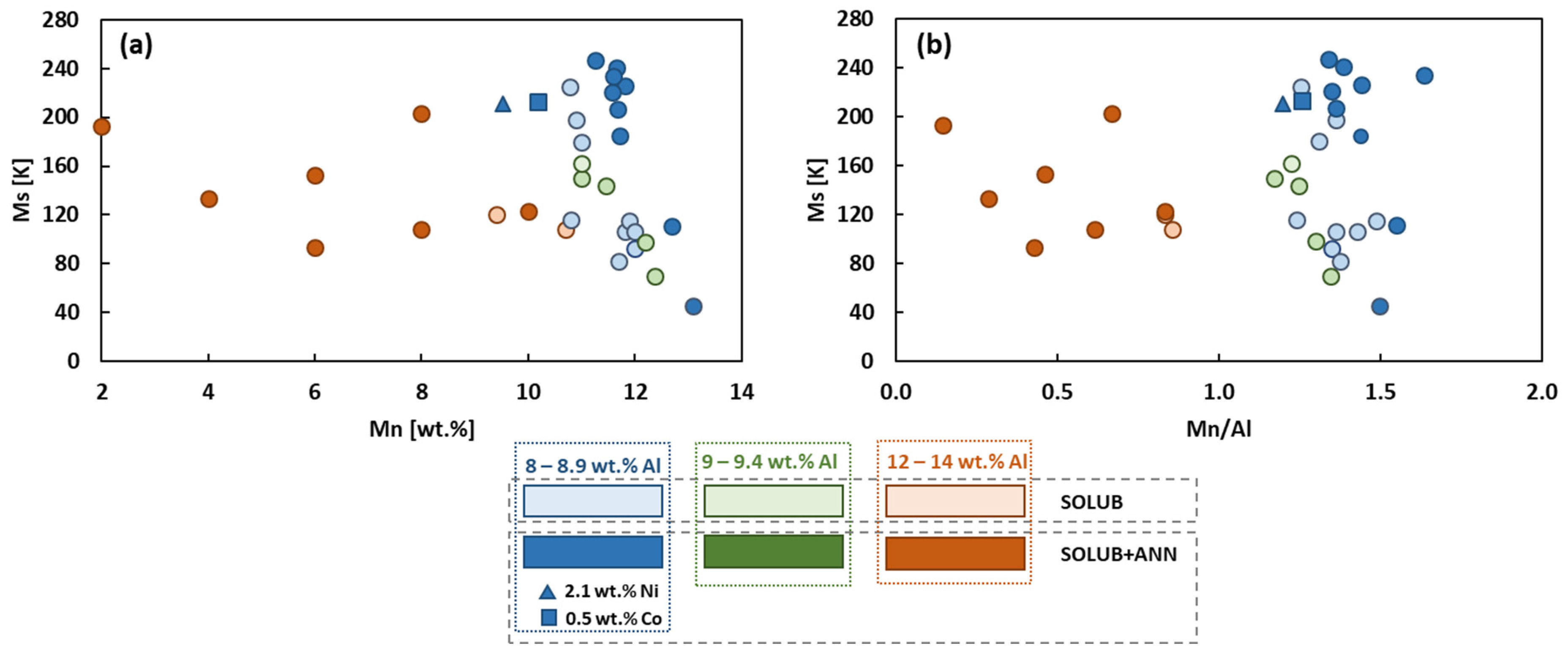
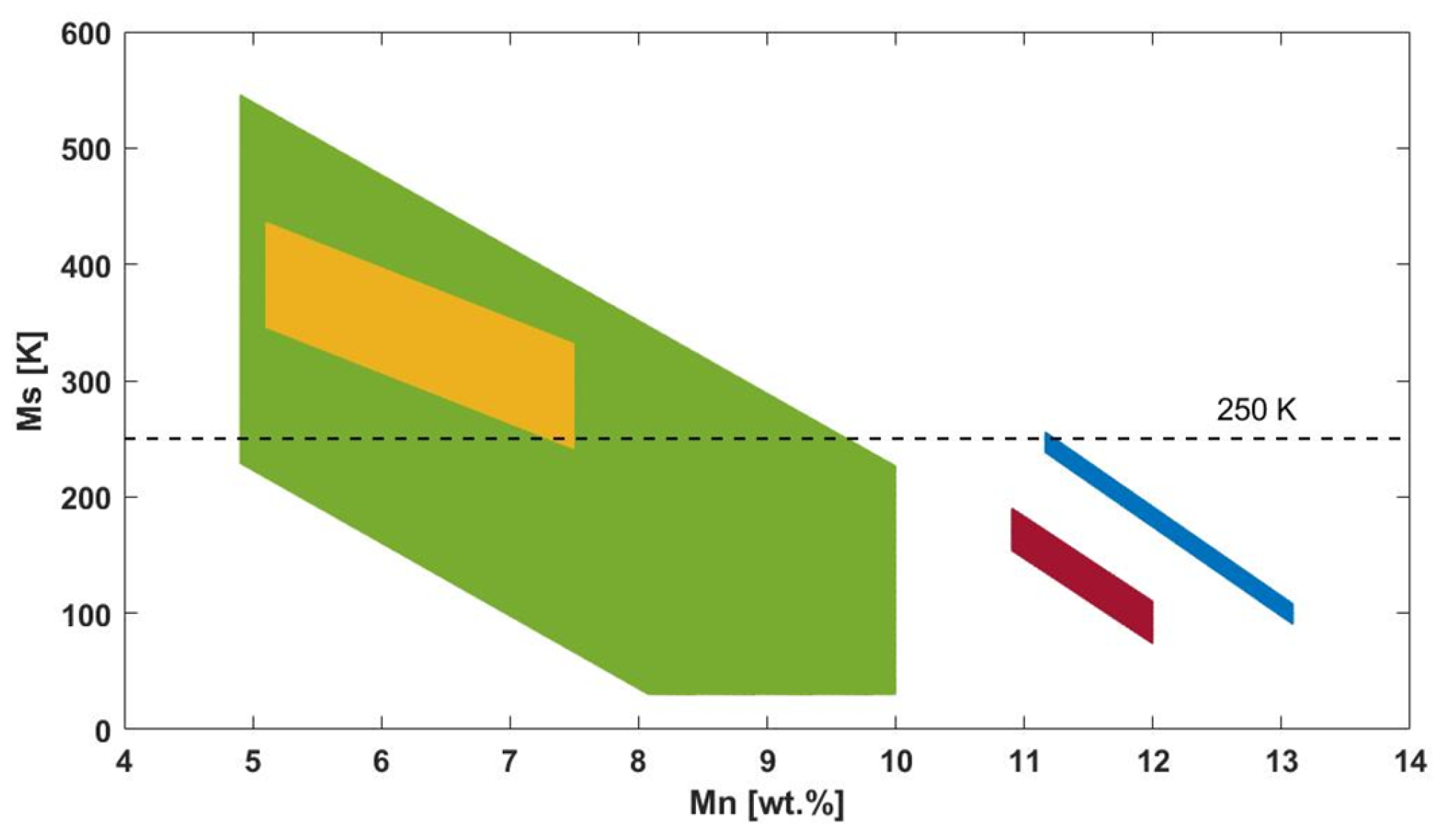
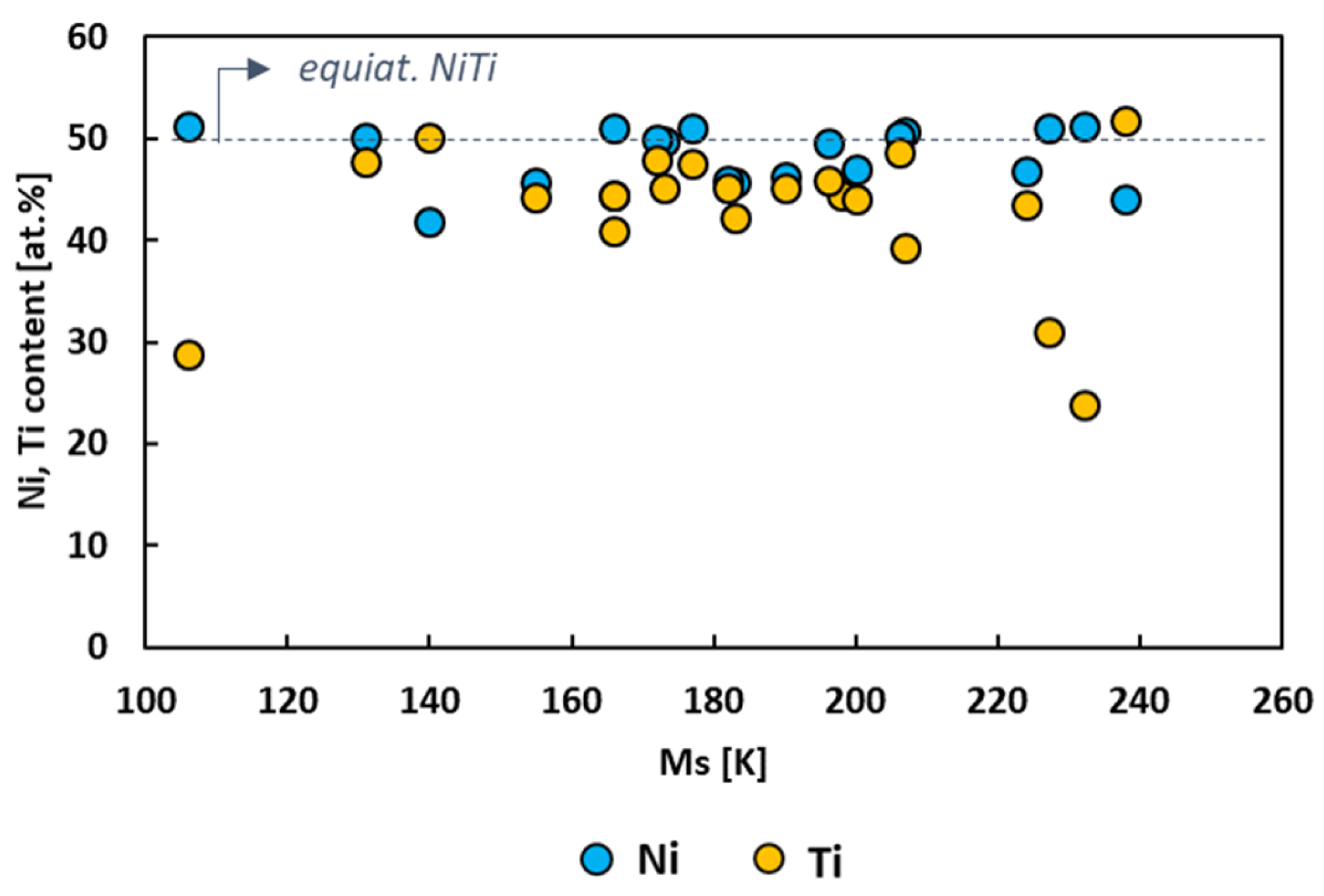
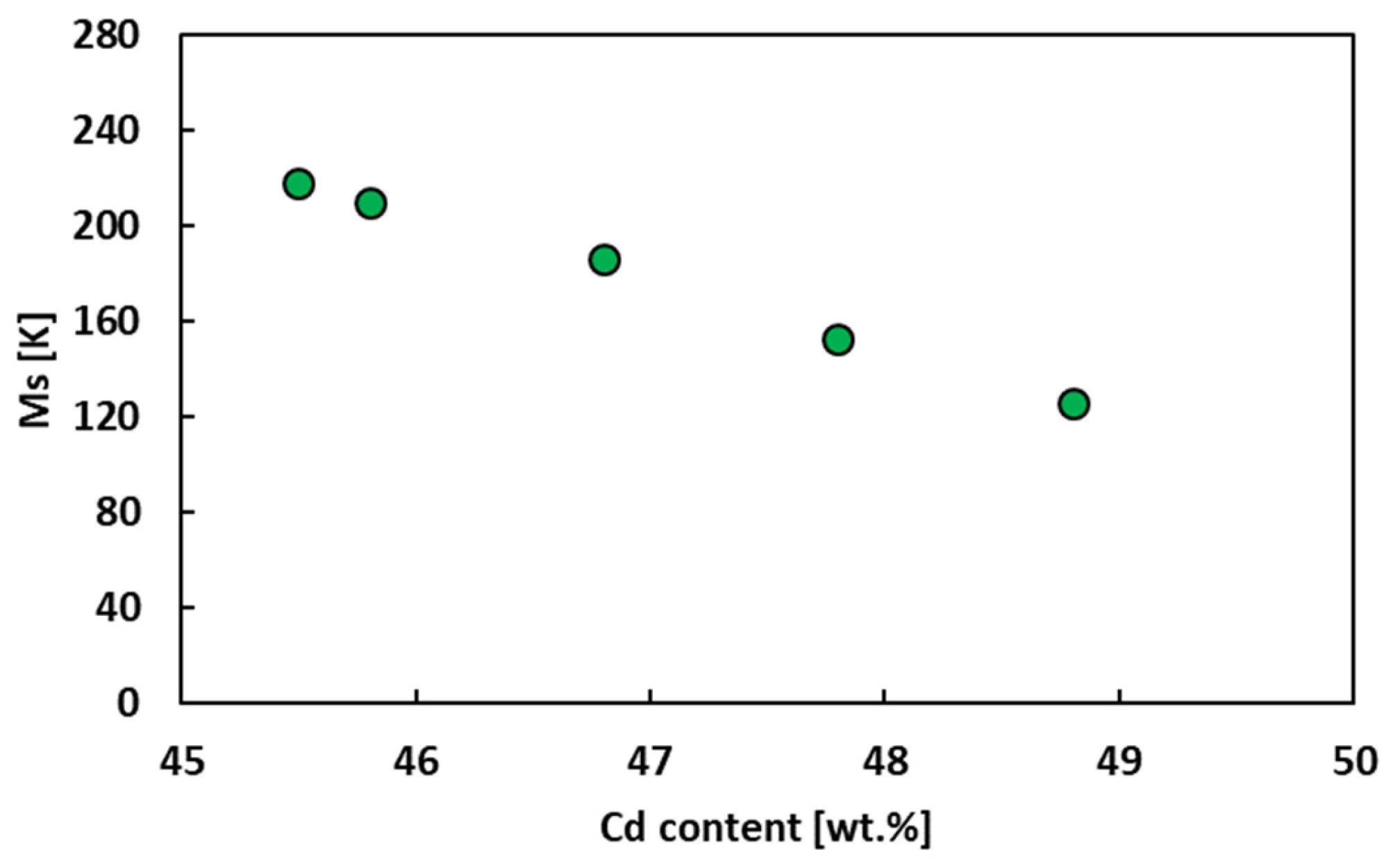

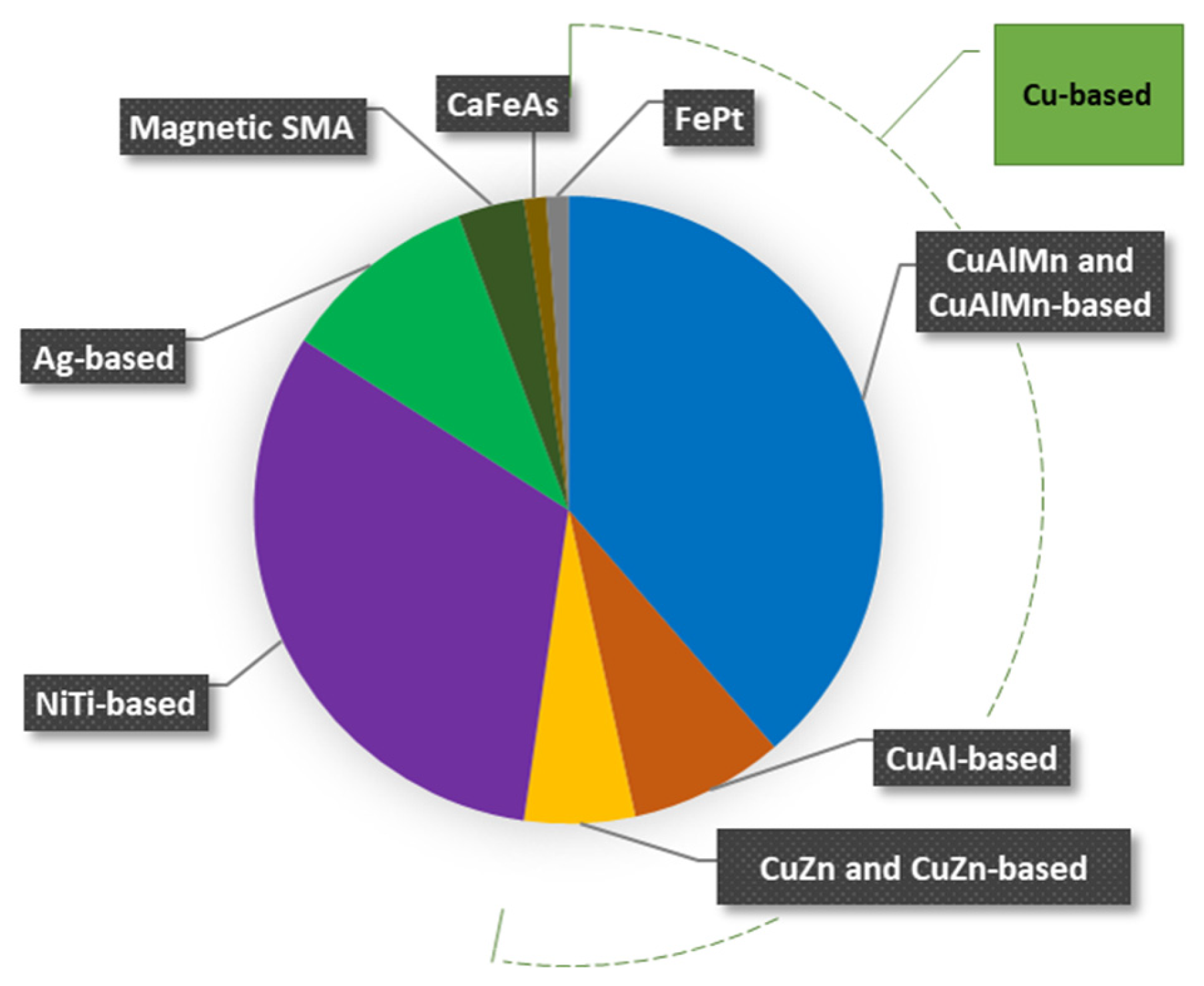
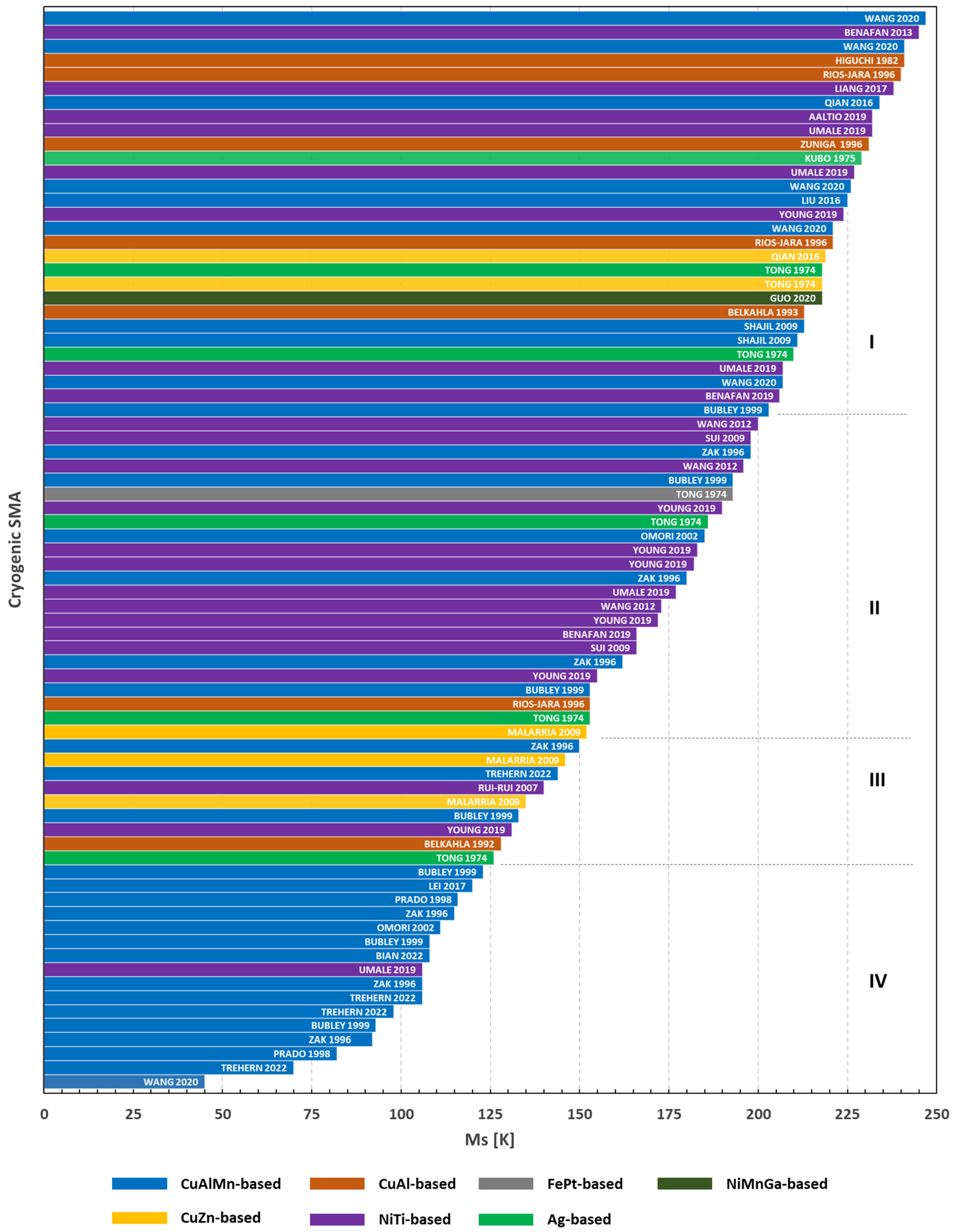
| Relationship | Al Range | Mn Range | Reference |
|---|---|---|---|
| Ms(K) = 1192 − 25.5Al(wt.%) − 73.2Mn(wt.%) | 8–9.5 wt.% | 10.9–12 wt.% | [18] |
| Ms (K) = 1890 − 42.1Al(at.%) − 78Mn(at.%) | 17.7–18.1 at.% | 11.4–13.3 at.% | [28] |
| Ms (K) = 1983 − 127.4Al(wt.%) − 43.6Mn(wt.%) | 10–11 wt.% | 5–7.5 wt.% | [29] |
| Ms (K) = 2129 − 63.2Al(at.%) − 63.9Mn(at.%) | 20–25 at.% | 5–10 at.% | [29] |
| Cu [wt.%] | Al [wt.%] | Mn [wt.%] | Ni [wt.%] | Co [wt.%] | Zn [wt.%] | Si [wt.%] | Be [wt.%] | Ms [K] | Af [K] | TT | REF. |
|---|---|---|---|---|---|---|---|---|---|---|---|
| 78.1 | 8.8 | 13.1 | - | - | - | - | - | 45 | 85 | A | [28] |
| 78.4 | 9.2 | 12.4 | - | - | - | - | - | 70 | 91 | S | [16] |
| 79.8 | 8.5 | 11.7 | - | - | - | - | - | 82 | ND | S | [19] |
| 79.1 | 8.9 | 12 | - | - | - | - | - | 92 | 123 | S | [18] |
| 80 | 14 | 6 | - | - | - | - | - | 93 | ND | A | [20] |
| 78.4 | 9.4 | 12.2 | - | - | - | - | - | 98 | 116 | S | [16] |
| 79.5 | 8.7 | 11.8 | - | - | - | - | - | 106 | 122 | S | [16] |
| 79.6 | 8.4 | 12 | - | - | - | - | - | 106 | 137 | S | [18] |
| 79 | 13 | 8 | - | - | - | - | - | 108 | ND | A | [20] |
| 76.8 | 12.5 | 10.7 | - | - | - | - | - | 108 | 145 | S | [17] |
| 79.1 | 8.2 | 12.7 | - | - | - | - | - | 111 | ND | A | [21] |
| 80.1 | 8 | 11.9 | - | - | - | - | - | 115 | 143 | S | [18] |
| 79.3 | 11.3 | 9.4 | - | - | - | - | - | 120 | ND | S | [27] |
| 78 | 12 | 10 | - | - | - | - | - | 123 | ND | A | [20] |
| 87.6 | 11.7 | - | - | - | - | - | 0.6 | 128 | ND | S | [32] |
| 82 | 14 | 4 | - | - | - | - | - | 133 | ND | A | [20] |
| 70.9 | 6.3 | - | - | - | 22.8 | - | - | 135 | ND | A | [30] |
| 79.3 | 9.2 | 11.5 | - | - | - | - | - | 144 | 157 | S | [16] |
| 72.2 | 6.7 | - | - | - | 21.1 | - | - | 146 | ND | A | [30] |
| 79.6 | 9.4 | 11 | - | - | - | - | - | 150 | 183 | S | [18] |
| 71.5 | 6.5 | - | - | - | 22 | - | - | 152 | ND | A | [30] |
| 87.9 | 11.5 | - | - | - | - | - | 0.6 | 153 | 152 | ND | [35] |
| 81 | 13 | 6 | - | - | - | - | - | 153 | ND | A | [20] |
| 80.5 | 8.7 | 10.8 | - | - | - | - | - | 161 | ND | S | [19] |
| 80 | 9 | 11 | - | - | - | - | - | 162 | 203 | S | [18] |
| 80.6 | 8.4 | 11 | - | - | - | - | - | 180 | 218 | S | [18] |
| 80.2 | 8.1 | 11.7 | - | - | - | - | - | 185 | ND | A | [21] |
| 84 | 14 | 2 | - | - | - | - | - | 193 | ND | A | [20] |
| 81.1 | 8 | 10.9 | - | - | - | - | - | 198 | 230 | S | [18] |
| 80 | 12 | 8 | - | - | - | - | - | 203 | ND | A | [20] |
| 79.7 | 8.6 | 11.7 | - | - | - | - | - | 207 | 224 | A | [28] |
| 80.4 | 8 | 9.5 | 2.1 | - | - | - | - | 211 | 230 | A | [22] |
| 81.2 | 8.1 | 10.2 | - | 0.5 | - | - | - | 213 | 232 | A | [22] |
| 87.03 | 12.5 | - | - | - | - | - | 0.47 | 213 | ND | S | [32] |
| 62.6 | - | - | - | - | 36.8 | 0.6 | - | 218 | ND | A | [15] |
| 74.5 | 7.4 | - | - | - | 18 | - | - | 219 | 234 | A | [25] |
| 87.67 | 11.79 | - | - | - | - | - | 0.54 | 221 | 219 | ND | [35] |
| 79.8 | 8.6 | 11.6 | - | - | - | - | - | 221 | 234 | A | [28] |
| 80.6 | 8.6 | 10.8 | - | - | - | - | - | 225 | 237 | S | [26] |
| 80.0 | 8.2 | 11.8 | - | - | - | - | - | 226 | 243 | A | [28] |
| 87.6 | 11.9 | - | - | - | - | - | 0.5 | 231 | 253 | S | [34] |
| 81.3 | 7.1 | 11.6 | - | - | - | - | - | 234 | 261 | S | [25] |
| 87.87 | 11.63 | - | - | - | - | - | 0.50 | 240 | 238 | ND | [35] |
| 87.95 | 11.46 | - | - | - | - | - | 0.59 | 241 | ND | A | [33] |
| 80 | 8.4 | 11.6 | - | - | - | - | - | 241 | 254 | A | [28] |
| 80.3 | 8.4 | 11.3 | - | - | - | - | - | 247 | 265 | A | [28] |
| Ni [wt.%] | Ti [wt.%] | Nb [wt.%] | Co [wt.%] | Fe [wt.%] | Hf [wt.%] | Sn [wt.%] | Ms [K] | Af [K] | TT | REF. |
|---|---|---|---|---|---|---|---|---|---|---|
| 34.9 | 13.2 | - | - | - | 51.8 | - | 232 | ND | S | [45] |
| 37.8 | 17.3 | - | - | - | 44.9 | - | 106 | ND | S | [45] |
| 38.9 | 19.3 | - | - | - | 41.8 | - | 227 | ND | S | [45] |
| 39.4 | 40.6 | - | - | - | - | 20 | 183 | 242 | S | [46] |
| 44.8 | 28.3 | - | - | - | 26.9 | - | 207 | ND | S | [45] |
| 45.8 | 37.4 | 14.7 | 2.1 | - | - | - | 166 | 228 | S | [43] |
| 46.2 | 45 | - | 8.8 | - | - | - | 140 | ND | A | [40] |
| 46.3 | 37.4 | 14.7 | 1.6 | - | - | - | 198 | 263 | S | [43] |
| 46.8 | 32.0 | - | - | - | 21.2 | - | 201 ** | ND | S | [44] |
| 46.9 | 30.7 | - | - | - | 22.4 | - | 166 | ND | S | [44] |
| 47.3 | 30.3 | - | - | - | 22.3 | - | 162 ** | ND | S | [44] |
| 47.6 | 46.6 | - | - | - | - | 5.8 | 224 | 271 | S | [46] |
| 47.7 | 29.9 | - | - | - | 22.3 | - | 178 ** | ND | S | [44] |
| 47.8 | 33.5 | - | - | - | 18.8 | - | 233 ** | ND | S | [44] |
| 48.4 | 36.9 | 14.7 | - | - | - | - | 200 | 262 | S | [42] |
| 48.4 | 46.5 | 1.7 | - | 3.4 | - | - | 238 | 240 | S | [39] |
| 49.3 | 35.8 | - | - | - | 14.9 | - | 211 ** | ND | S | [44] |
| 50.8 | 45.0 | - | - | 4.2 | - | - | 232* | 240 | S | [38] |
| 51.9 | 44.6 | - | - | 3.5 | - | - | 245 * | 267 | A | [36] |
| 52.0 | 38.7 | - | - | - | 9.3 | - | 224 ** | ND | S | [44] |
| 52.6 | 39.0 | 8.4 | - | - | - | - | 173 | 255 | S | [42] |
| 52.7 | 39.7 | 7.6 | - | - | - | - | 196 | 262 | S | [42] |
| 52.8 | 40.8 | - | - | - | 6.4 | - | 185 ** | ND | S | [44] |
| 53.1 | 41.5 | - | - | - | - | 5.4 | 155 | 215 | S | [46] |
| 53.3 | 41.8 | - | - | - | - | 4.9 | 182 | 232 | S | [46] |
| 53.5 | 42.2 | - | - | - | - | 4.3 | 190 | 241 | S | [46] |
| 53.7 | 42 | - | - | - | - | 4.3 | 172 | 228 | S | [46] |
| 53.9 | 41.8 | - | - | - | - | 4.3 | 131 | 191 | S | [46] |
| 54.1 | 42.7 | - | - | - | 3.3 | - | 206 | ND | S | [44] |
| 54.1 | 41.1 | - | - | - | 4.8 | - | 177 | ND | S | [45] |
Disclaimer/Publisher’s Note: The statements, opinions and data contained in all publications are solely those of the individual author(s) and contributor(s) and not of MDPI and/or the editor(s). MDPI and/or the editor(s) disclaim responsibility for any injury to people or property resulting from any ideas, methods, instructions or products referred to in the content. |
© 2023 by the authors. Licensee MDPI, Basel, Switzerland. This article is an open access article distributed under the terms and conditions of the Creative Commons Attribution (CC BY) license (https://creativecommons.org/licenses/by/4.0/).
Share and Cite
Nespoli, A.; Ninarello, D.; Fanciulli, C. A Review on Shape Memory Alloys with Martensitic Transition at Cryogenic Temperatures. Metals 2023, 13, 1311. https://doi.org/10.3390/met13071311
Nespoli A, Ninarello D, Fanciulli C. A Review on Shape Memory Alloys with Martensitic Transition at Cryogenic Temperatures. Metals. 2023; 13(7):1311. https://doi.org/10.3390/met13071311
Chicago/Turabian StyleNespoli, Adelaide, Davide Ninarello, and Carlo Fanciulli. 2023. "A Review on Shape Memory Alloys with Martensitic Transition at Cryogenic Temperatures" Metals 13, no. 7: 1311. https://doi.org/10.3390/met13071311
APA StyleNespoli, A., Ninarello, D., & Fanciulli, C. (2023). A Review on Shape Memory Alloys with Martensitic Transition at Cryogenic Temperatures. Metals, 13(7), 1311. https://doi.org/10.3390/met13071311







